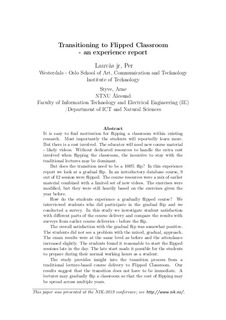Transitioning to Flipped Classroom - an experience report
Journal article, Peer reviewed
Accepted version

Åpne
Permanent lenke
http://hdl.handle.net/11250/2594404Utgivelsesdato
2018Metadata
Vis full innførselSamlinger
- Institutt for IKT og realfag [594]
- Publikasjoner fra CRIStin - NTNU [38015]
Originalversjon
NIK: Norsk Informatikkonferanse. 2018Sammendrag
It is easy to find motivation for flipping a classroom within existing research. Most importantly the students will reportedly learn more. But there is a cost involved. The educator will need new course material - likely videos. Without dedicated resources to handle the extra cost involved when flipping the classroom, the incentive to stay with the traditional lectures may be dominant.
But does the transition need to be a 100% flip? In this experience report we look at a gradual flip. In an introductory database course, 9 out of 12 session were flipped. The course resources were a mix of earlier material combined with a limited set of new videos. The exercises were modified, but they were still heavily based on the exercises given the year before.
How do the students experience a gradually flipped course? We interviewed students who did participate in the gradual flip and we conducted a survey. In this study we investigate student satisfaction with different parts of the course delivery and compare the results with surveys from earlier course deliveries - before the flip.
The overall satisfaction with the gradual flip was somewhat positive. The students did not see a problem with the mixed, gradual, approach. The exam results were at the same level as before and the attendance increased slightly. The students found it reasonable to start the flipped sessions late in the day. The late start made it possible for the students to prepare during their normal working hours as a student.
The study provides insight into the transition process from a traditional lecture-based course delivery to Flipped Classroom. Our results suggest that the transition does not have to be immediate. A lecturer may gradually flip a classroom so that the cost of flipping may be spread across multiple years.